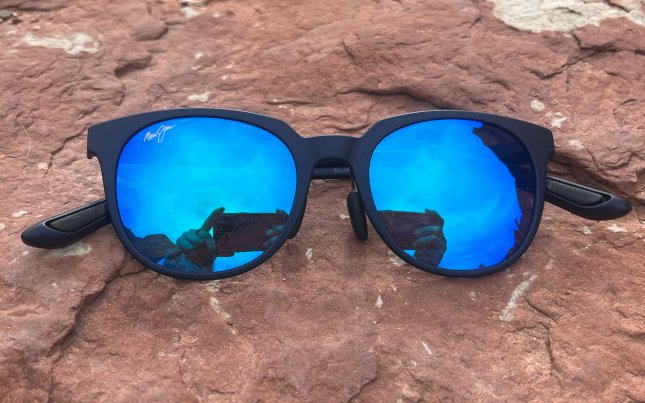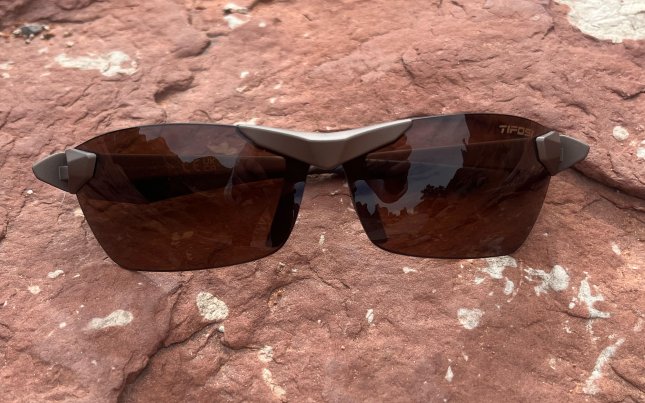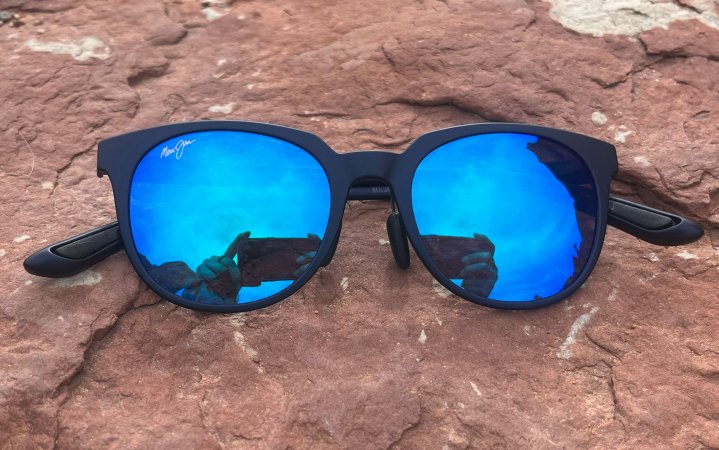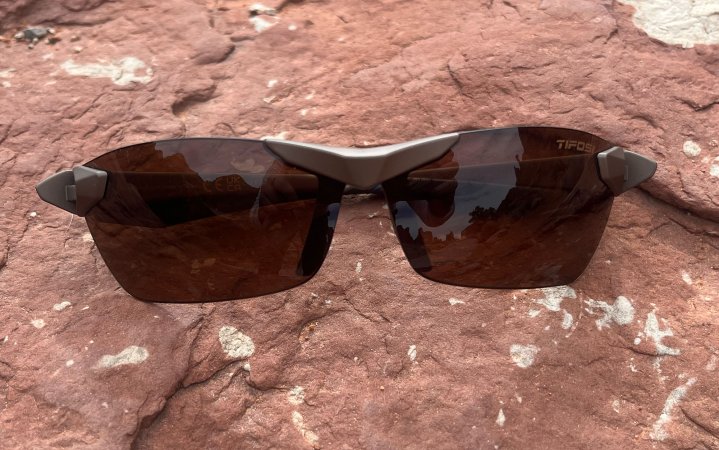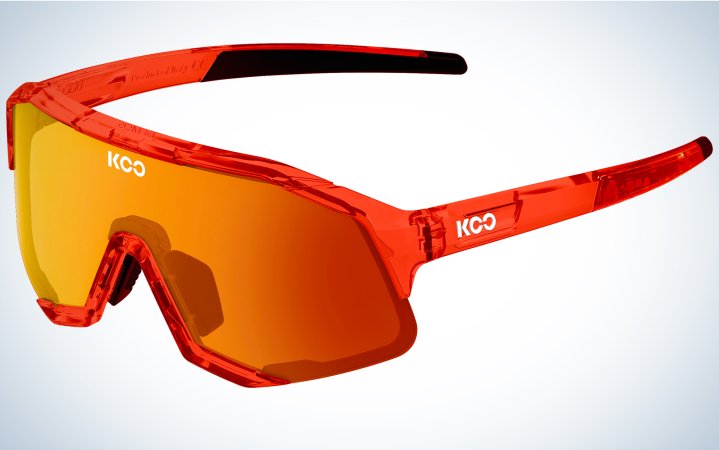We may earn revenue from the products available on this page and participate in affiliate programs. Learn More ›
While hiking sunglasses can be a fashion statement, afterthought, or impulse buy, they’re a necessity if you spend a lot of time outside. Especially while hiking, sunglasses are a serious piece of eye protection. They protect your eyes from harmful UV rays, blue light, dirt, and branches. While a gas station pair can get you by for a weekend, if you invest in a quality pair, you’ll deal with less scratching, fogging, distortion, and have an overall clearer image. I tested the best hiking sunglasses from top brands to determine how they perform on the trail, and here are the results.
- Best Overall: Costa Caleta
- Best Budget: Goodr Everglades
- Best Ultralight: Maui Jim Wailua
- Best for Mountaineering: Julbo Vermont Classic
- Best for Hunting: Leupold Cheyenne
- Best for Running: Tifosi Seek 2.0
- Best Floatable: Dragon H2O Mari
- Best for the Beach: Bajio Parasio
- Best Full Coverage: KOO Demos
How I Tested the Best Hiking Sunglasses

I wore all of these sunglasses hiking in the desert and mountains to test the fit, lenses, and polarization. The hiking sunglasses on this list were picked specifically for active outdoor adventures, so I took note of the comfort and reliability of each pair considering the glasses you bring on-trail are usually the only form of eye protection you have for the duration of your trip. I also weighed each pair for ounce-cutters and runners. All weights listed in the key features section were measured, not advertised unless otherwise noted.

Durability is a huge concern when hiking with sunglasses because if your pair detrimentally scratches or breaks, you’re either stuck with an obscured field of vision or forced to go without. I always scratch my cheap sunglasses backpacking by tucking them into a strap on my heavy pack and then hurling it to the ground once it’s time for a break, inevitably sending my sunglasses crashing into a rock.
So I recreated this scenario by attaching all of the sunglasses to a loaded pack and dropping them on concrete stairs three times. This is extreme abuse, but surprisingly most pairs passed with either no scratches or a mild amount. However, the Under Armour Gameday glasses were removed from testing at this point.
Best Hiking Sunglasses: Reviews & Recommendations
Best Overall: Costa Caleta
Best Overall
Costa Caleta
Key Features
- Lens: Gray polarized glass
- Weight: 45 g
- Frames are 97 to 100 percent recycled fishing nets
- C-Wall coating provides extra scratch-resistance and repels water, oil, and sweat
- Absorbs high-energy blue light (HEV)
- Enhances reds, greens, and blues
- Filters out harsh yellow
- Durability Test: Pass
- Price: $209
Pros
- Glass lenses
- Available in prescription
- Sustainably made
- True color perception
Cons
- Heavier
- Warranty only covers manufacturer defects, and you pay shipping


As soon as I put on the Costa Caleta, I was blown away by the crisp, quality image. There was no distortion and the true colors of the landscape came through while still shading my eyes. The frame is wide with a medium fit, and fits my medium square face well. While they do feel heavier than other pairs thanks to the glass lenses, once adjusted properly the weight benefits the snug fit by resting on the nose bridge naturally. If you tend to look down at the trail most of your hike, these won’t fall off, but you could notice the weight more. During the durability testing these sustained four 1mm scratches and one 2 mm scratch on one lens. While wearing the Caleta, these scratches feel insignificant and my eyes easily adjust to not notice them.
Costa’s Untangled collection, including the Caleta, is also sustainable thanks to the recycled fishing nets that make up the frame. It has a slightly coarser feeling to it than typical plastic, but it’s better for the planet and doesn’t catch in my hair or irritate my skin even when sweating. When working up a sweat in chilly 40 degree temps, I didn’t experience any fogging. While scrambling up a few rocks, these sunglasses did not slide or fall, though after an extended period of time I felt some pressure on my temples. The UV protection, color enhancement, and blue light filtering make these the overall best hiking sunglasses. I’d especially recommend the Caleta for day hikes in gorgeous places where you want to take in the views with clear lenses and sturdy frames.
Best Budget: Goodr Everglades
Best Budget
Goodr Everglades
Key Features
- Lens: Mirrored polarized TAC lenses
- Weight: 22 g
- Glare-reducing
- Scratch-resistant
- Portion of proceeds from National Parks collection go to the National Parks Foundation
- Durability Test: Pass
- Price: $30
Pros
- Stylish
- Lightweight
- Comfortable
Cons
- Lens quality


Goodr has tons of styles and colors available at just $25 to $30. This means it’s not the end of the world if you do lose or break a pair. However with the snug fit, these won’t bounce or slip off your face while active. The Everglades didn’t fog up and every pair is polarized to reduce glare. They might not be the highest quality lenses due to the color change, but they passed the durability testing. There were two 5 mm scratches on one lens that did remove some of the green color on the outside, but aren’t very noticeable when worn. The frames received two scratches that are purely aesthetic.
I was impressed that a budget frame outperformed the Under Armour Gameday glasses (which are four times the price) in the durability test. My favorite thing about the Everglades though is the weight. They’re extremely light and comfortable without bouncing during high-intensity exercise. I’d recommend these for tough trips when you need protection and optimal performance, but don’t have the option to baby your gear.
Best Ultralight: Maui Jim Wailua
Best Ultralight
Maui Jim Wailua
Key Features
- Lens: MauiPure blue Hawaii PolarizedPlus2
- Available Lenses: Neutral gray, high contrast bronze, and Hawaii lava
- Weight: 15 g
- Bi-Gradient mirror
- Scratch and shatter resistant
- Rubber nose and ear pieces
- Water and oil proof
- Blue light protection
- Durability Test: Pass
- Price: $249
Pros
- Ultralight
- Adjustable nose pieces
- Available in prescription
Cons
- Expensive


The Wailua are comfortable and clear with impressive features that just might justify the price tag. The MauiPure lens is a composite lens that gets close to the crispness of glass while weighing the same as a CD. They sustained eight scratches under 1 mm during the durability test on one lens. This is an admiral performance, and the scratches don’t bother me, but they are more noticeable than the other glasses that sustained similar damage because it is obvious that the advanced polarization has been removed in pinpricks, resulting in a negligible glare when you move your head.
However, this proves that the PolarizedPlus2 technology efficiently blocks the horizontal glare that is usually responsible for eye-fatigue. Since the frame is narrower, it does allow more light in from the edges. Because the lenses are water and oil resistant, I’m able to easily wipe away fingerprints and sweat during my hikes. These are ideal for an ultralight backpacker looking for a quality pair of sunglasses to bring on every trip.
Best for Mountaineering: Julbo Vermont Classic
Best for Mountaineering
Julbo Vermont Classic
Key Features
- Lens: Brown/multilayer gold polarized Spectron 3 polycarbonate
- Available Lenses: Smoke/multilayer green, Brown/gold pink, smoke/multilayer blue, brown/silver flash
- Weight: 41 g (40 g advertised)
- Grip Tech temples with Earbend
- Leather side shields
- Metal Frame
- Replacement parts sold separately
- Durability Test: Aced
- Price: $159.95
Pros
- Leather side shields
- Breathable
- Unique, vintage look
Cons
- No peripheral vision


Glacier glasses are specially designed to block light reflecting off of snow from alternate angles, hence the leather side shields. While there are other versions using plastic shields, the originals used leather and Julbo is bringing back the vintage style. I didn’t feel any pressure from the arms or side shields while hiking. The Vermont Classics are the best hiking sunglasses for snow, because they use exclusive Grip Tech material on the flexible, hooked arms that don’t stick to hair, feel soft on your temples, and don’t fall off your face. Afterall, if your glasses fall off on trail, you might have to brush some dirt off; if they fall off on top of a mountain, you could never see them again, lost in deep powder or over the edge.


These mountaineering sunglasses are more breathable than I anticipated thanks to the lack of nose piece. While the majority of your eye is protected from any harmful light, there’s plenty of airflow through the middle to prevent fogging while sweating in cold conditions. At first, I experienced some minor fog once I stopped, but adjusting them a bit higher on my face fixed the issue. The Julbos aced the durability test with no damage whatsoever. But if something does break (or you want to Frankenstein a one-of-a-kind pair), Julbo offers replacement parts sold as a pair. The lack of peripheral vision didn’t bother me on trail, allowing my eyes to relax in the extra-bright conditions, but don’t drive in these.
Best for Hunting: Leupold Cheyenne
Best for Hunting
Leupold Cheyenne
Key Features
- Lens: Brown mirror polarized
- Available Lenses: Shadow gray flash, blue mirror
- Weight: 31 g
- ANSI Z87-2+ ballistic rating
- In-fused polarization won’t scratch or deteriorate over time
- Hydrophobic lens coating sheds dirt and water
- DiamondCoat
- Decentered lens
- No slip nose bridge and arm tips
- Limited Lifetime Guarantee
- Durability Test: Aced
- Price: $189.99
Pros
- Scratch resistant DiamondCoat
- ANSI rated
- Made in the USA
Cons
- Large lenses for small faces


The Leupold Cheyenne has a full wrap design that offers increased protection from the sun, debris, and casings. It’s the only pair rated for shooting making it ideal for hunting. The excellent visibility and air flow make them great for scouting, spot-and-stalk, and long pack outs. You can get some serious vertical feet in while working up a sweat with no fogging while being sure your eyes are protected if you take a shot. The brown polarization is great for bright, green environments and acquiring a moving target. These lenses are also decentered, which sounds counterproductive, but actually improves clarity. Each lens is designed to fit within the perspective frame so that the clearest part is directly in front of the eye.

The Cheyennes aced the durability test with no damage. I have managed to minorly scratch my black pair of Cheyennes over the past three years, but I do tend to abuse sunglasses more than any other piece of gear I own. The 8 mm circle of scratches don’t distract me while wearing the glasses. Happily, if you damage any performance eyewear from Leupold, they can repair or replace them for a fee. There is a lifetime warranty on manufacturer defects. While Leupold says these frames are low-profile, they are still large for my face. This doesn’t affect fit, only aesthetics.
Best for Running: Tifosi Seek 2.0
Best for Running
Tifosi Seek 2.0
Key Features
- Lens: Iron polarized polycarbonate
- Available Lenses: Enliven golf, smoke, smoke bright blue
- Weight: 18 g (21 g advertised)
- Grilamid TR-90 frame
- Embedded polarized layer
- Shatterproof
- Hydrophilic rubber ear and nose pieces
- Comfort Grip
- Durability Test: Aced
- Price: $59.95
Pros
- Lightweight
- Hydrophilic grips
- Durable
Cons
- More functional than aesthetically pleasing


If you want to protect your eyes while feeling like you aren’t wearing sunglasses at all, the Tifosi Seek 2.0 is for you. These are excellent at comfortably staying in place thanks to the Comfort Grip technology. Essentially, the ends of the arms are a stiff rubber that can be bent to 90 degrees and immediately returns to its original shape once you let go. It adds a flex to the ear pads that holds the sunglasses securely without causing pressure, also allowing them to fit a wide range of face sizes. The Grilamid TR-90 frame is a durable and lightweight material that retains its shape. This material paired with the Comfort Grip and rimless lenses makes for a barely-there pair that won’t bug you, even during high-intensity workouts.
Besides the comfortable fit, the Seek 2.0 is best for running because it handles sweat differently than other sunglasses. The hydrophilic ear and nose pieces increase grip the more you sweat. The other best hiking sunglasses relied on fit to stay in place while sweating, but the Tifosi’s material was even more grippy when wet. I also appreciate that the streamlined frames decrease the footprint susceptible to embarrassing glasses tan lines. One drawback is that these frames don’t look great on everyone, but they’ll only see you for a second before you pass them, right?
Best Floatable: Dragon H2O Mari
Best Floatable
Dragon H2O Mari
Key Features
- Lens: Lumalens Smoke Polar 6-layer nylon
- Available Lenses: Sky Blue polar
- Weight: 24 g
- Floatable TPX frames
- Hydrophobic and oleophobic
- Hard coating
- Filters blue and green light
- Durability Test: Pass
- Price: $219
Pros
- Floats in water
- Comfortable fit
- Filters blue light to reduce eye fatigue
Cons
- Expensive


Dragon’s Lumalens technology filters out blue and green light attributed to haze and glare while enhancing the landscape’s true color. The reduction of blue light also prevents eye fatigue. These are comfortable to wear but have a large frame which felt a bit big for my medium sized face. During the durability test these sustained shallow 5 mm scratches on both lenses and five pricks under 1 mm distributed across both lenses. They’re easy to ignore though not unnoticeable when wearing the glasses.

If you’re floating a river, scrambling through a stream, or hiking to your fishing spot, the Mari are the pair for you. I’ve lost plenty of sunglasses in bodies of water, and it makes the rest of your hike a lot less enjoyable. The Mari’s frames are made with injection molded resin that has a lower density than water, allowing them to float.
Best for the Beach: Bajio Parasio
Best for the Beach
Bajio Parasio
Key Features
- Lens: Rose mirror polarized polycarbonate
- Available Lenses: Gray, blue mirror, green mirror, silver mirror, copper, violet mirror
- Weight: 30 grams (polycarbonate), 39 grams (glass)
- Bio-based nylon frames
- Proprietary non-slip rubber nose pads
- Rubber temple tips for no-slip fit
- Blue light-blocking LAPIS technology
- Scratch resistant and oleophobic
- Durability Test: Fail (polycarbonate), Aced (glass)
- Price $209
Pros
- Filters blue light
- Available in prescription
- Available in glass for $50 more
Cons
- A little tight on the temples


These lenses are coated to allow for easy cleaning; when I touch the lenses my fingerprints barely leave a mark, which is easily wiped away. If your trail takes you along the coast or you plan on scrambling by the ocean, these glasses are designed for it. They filter blue light to ease eye strain and eliminate glare off the water. On trail they fit snugly and provide a clear image. The polarization and blue light filtering does change the colors of your view significantly. They are also a bit tight on the temples. However, they will stay put thanks to rubberized nose and ear pads.
Unfortunately the Parasio with polycarbonate lenses failed the durability test. They sustained a 20 mm scratch accompanied by three 5 mm scratches, and a collection of scratches under 1 mm on one lens and three 1 mm scratches on the other. For $50 extra dollars I would recommend buying the glass lenses for increased scratch resistance. This pair aced the durability test without a scratch. You can also send your glasses back to Bajio for a warranty or repair. Though if you take care of these sunglasses, they will take care of you.
Best Full Coverage: KOO Demos
Best Full Coverage
KOO Demos
Key Features
- Lens: Red mirror Zeiss polycarbonate
- Available Lenses: Blue mirror, green mirror, pink mirror, red mirror, turquoise mirror, orange mirror, and brown mirror
- Weight: 33 g
- Colored transparent single-lens frame design
- Anti-slip MEGOL elastomer temple inserts
- Adjusting foldable nose pieces
- Four ventilation ports
- Zeiss Anti-Reflective
- Durability Test: Pass
- Price $190
Pros
- No fogging
- Full-coverage
- Replaceable lenses
Cons
- Anti-slip arms get caught in long hair
- Not polarized
These glasses fully protect your eyes from the sun so you don’t have to squint when the sun is right above you. The ventilation ports allow for free air flow so the glasses don’t fog up while hiking. Anti-slip temple pieces sometimes get caught in my hair but these frames definitely won’t fall off my face. While not polarized, the lens quality is clear and the anti-reflection technology does decrease glare. The lens’ anti-reflection technology reduces eye strain while still allowing in the most light possible. This retains the natural color and clarity of your view.


During the durability test, the glasses suffered a 24 mm scratch on one side of the lens and two 11 mm scratches on the other side with nine 1 mm scratches scattered about. However these are mostly aesthetic on the red mirrored lens as my view is still generally unobstructed. And I’ll continue to wear these glasses on very sunny endeavors because they keep light out from all angles. The adjustable nose pieces are also extremely convenient because they audibly click when you adjust them so it’s easy to set them equally and reliably.
How to Choose the Best Hiking Sunglasses
Lens
All of the sunglasses on this list provide 100 percent protection from UV rays. Sunglass lenses are typically either plastic, usually polycarbonate, or glass. There are pros and cons to each. Glass lenses are heavier and more fragile (never wear glass lenses while shooting or hunting), but they are extremely scratch resistant and provide the clearest image with no distortion. Plastic lenses can be shatterproof, lighter, and offer more versatile color options, but they can also scratch more easily and are more prone to distortion.
Polarization

Polarized lenses reduce glare and are usually preferred when hiking. If it’s a shady day you might not notice, but otherwise it’s an extremely helpful tool. When you’re near water or snow, polarization is especially important because these surfaces reflect light back to your eyes. If you’re on the water, it can help you see fish, wind, and current more clearly. The different colors of polarization each have a purpose for helping you see more clearly. Reference the table below for an idea on what each color lens can offer.
| Polarization | Purpose |
| Red, Pink | Eases eye strain by reducing harsh contrasts and better depth perception |
| Orange, Yellow, Gold | Provides clarity in hazy conditions and helps focus on movement |
| Green | Brightens shadows, versatile |
| Blue, Purple | Reduces glare from snow and water |
| Brown | Increased depth perception and color contrast. Warm tones |
| Gray | Accurate color representation and glare reduction |
Fit
The best hiking sunglasses should fit just as well as the best hiking shoes; you’re wearing both near constantly on trail. They should fit snugly so they aren’t moving around on your face during extreme movement or falling off when you look down to avoid a rock. The nose and ears sometimes utilize grippy sections to keep them in place. However, they shouldn’t be so snug that they hurt or stifle airflow. Your glasses should be breathable and not fog up once you work up a sweat. Some offer more peripheral protection from sun rays. When hiking long distances, a lightweight pair can be more comfortable.
Durability
Your sunglasses should be able to withstand some mild abuse if you’re constantly wearing them on the trail. Frames that won’t permanently bend out of shape and lenses that don’t scratch easily will prolong the life of your sunglasses.
Budget
Performance isn’t always reflected in the price of sunglasses. Brand name glasses sometimes fail and our budget pick is surprisingly capable. If you constantly lose sunglasses, consider the best floatable sunglasses so you don’t have to replace them so often. If you do choose to tackle a big mission, investing in a quality pair of hiking sunglasses could make your adventure a lot more enjoyable. Keep in mind that these are sitting on your face all day, if they are constantly slipping, fogging, or bothering you, it’s going to mess with your whole day, or trip.
Style
The best hiking sunglasses are a daily accessory worn with all different outfits and they will be in all of your photos. While the most functional pair has its benefits, don’t rule out how certain colors and styles look. Researching what styles look best on your face shape can help. Your face shape can also affect how certain designs fit you and if they’ll fog up or not.
FAQs
Yes, polarized sunglasses are good for hiking. They reduce glare and decrease eye strain to keep your eyes sharp and protected on trail.
All of the glasses on this list came with at least a soft case, if not also a hard case. Hard cases are cumbersome but sometimes necessary for travel so that you don’t permanently bend your frames. Typically I tuck my glasses into a shirt or on a strap when I’m not wearing them, but this is why most of my hiking glasses are scratched from falling. It’s best to store them in the soft bag inside a secure pocket that you won’t smush.
You should wear sunglasses in all bright conditions to protect your eyes from long-term damage. UV light, branches, debris, and blue light are some of the irritants that can affect your vision if you don’t wear eye protection. While sunglasses can be fashionable and fun, they serve a real purpose in protecting one of the most sensitive and crucial parts of your body.
Final Thoughts
The best hiking sunglasses are necessary for sun protection, but can also make your hike more fun. I recommend a polarized pair for better vision in high-glare situations. Glass lenses like the Costa Caletas have superior clarity and scratch resistance, but are more fragile and heavy. The ANSI rated Leupold lenses are shatterproof and the only pair on this list that you should be shooting in, but plenty of the other polycarbonate lenses are also durable and surprisingly crisp.
- Best Overall: Costa Caleta
- Best Budget: Goodr Everglades
- Best Ultralight: Maui Jim Wailua
- Best for Mountaineering: Julbo Vermont Classic
- Best for Hunting: Leupold Cheyenne
- Best for Running: Tifosi Seek 2.0
- Best Floatable: Dragon H2O Mari
- Best for the Beach: Bajio Parasio
- Best Full Coverage: KOO Demos


